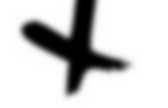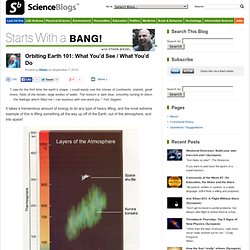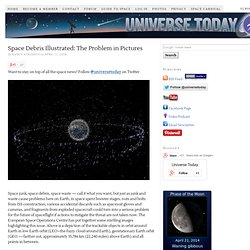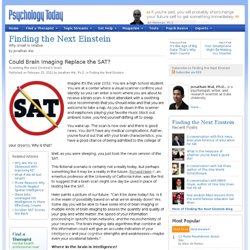

WIX Create Your Free Website. XMind - Mind Mapping and Storming. Create Website Online Web Apps. Chakras. Secret Societies. Hidden History. BODY LANGUAGE. Neanderthal. Orbiting Earth 101: What You’d See / What You’d Do. “I saw for the first time the earth’s shape.

I could easily see the shores of continents, islands, great rivers, folds of the terrain, large bodies of water. The horizon is dark blue, smoothly turning to black. . . the feelings which filled me I can express with one word–joy.” -Yuri Gagarin It takes a tremendous amount of energy to do any type of heavy lifting, and the most extreme example of this is lifting something all the way up off of the Earth, out of the atmosphere, and into space! And once you’re up there, at least 300 km above the Earth’s surface, the sights you’ve got are bound to be absolutely amazing! But gravity is a funny thing. Space Debris Illustrated: The Problem in Pictures.
Want to stay on top of all the space news?

Follow @universetoday on Twitter Space junk, space debris, space waste — call it what you want, but just as junk and waste cause problems here on Earth, in space spent booster stages, nuts and bolts from ISS construction, various accidental discards such as spacesuit gloves and cameras, and fragments from exploded spacecraft could turn into a serious problem for the future of spaceflight if actions to mitigate the threat are not taken now.
The European Space Operations Centre has put together some startling images highlighting this issue. Above is a depiction of the trackable objects in orbit around Earth in low Earth orbit (LEO–the fuzzy cloud around Earth), geostationary Earth orbit (GEO — farther out, approximately 35,786 km (22,240 miles) above Earth) and all points in between. Officials from the space shuttle program have said the shuttle regularly takes hits from space debris, and over 80 windows had to be replaced over the years. Photojournal: NASA's Image Access Home Page. Glowing Nebula's Clouds Look Like Giant Human Face in New Photo. The wispy clouds of a distant nebula bursting with newborn stars take on an eerie face-like shape sculpted by stellar winds in a new photo snapped by a telescope in Chile.

The hotbed of star birth, called NGC 3324, is full of hot young stars, whose ultraviolet radiation is making the gas clouds glow. The stellar wind and radiation from the newborn stars has also punched out a cavity in the surrounding gas and dust. The edge of the wall of gas and dust at the right in the photo resembles the profile of a human face, with a ridge in the center that looks like a nose. Astronomers often attach nicknames to nebulas based on their shape and their earthly likenesses. NGC 3324 is sometimes called the Gabriela Mistral nebula, after the Nobel Prize-winning poet from Chile, ESO officials said. The new image was captured by the Wide Field Imager on the MPG/ESO 2.2-meter telescope at the European Southern Observatory's (ESO) La Silla Observatory in Chile's Atacama Desert. Nebulosa fotografiada desde Chile es bautizada “Gabriela Mistral” por formar el rostro de la poetisa.
No sólo el humo o las nubes se despliegan dando lugar a curiosas formas.

Mucho más allá, en el espacio, el gas y polvo cósmicos también pueden agruparse en nebulosas hirvientes de vida, donde nacerá una nueva generación de estrellas. Radical theory explains the origin, evolution, and nature of life, challenges conventional wisdom. Utopia now! Could Brain Imaging Replace The SAT? Imagine it's the year 2032.

You are a high school student. You are at a center where a visual scanner confirms your identity so you can enter a room where you are about to receive a brain scan. A robot attendant with a soothing voice recommends that you should relax and that you are welcome to take a nap. As you lie down in the scanner and earphones playing your favorite music block out ambient noise, you find yourself drifting off to sleep . You wake up. Well, as you were sleeping, you just took the neuro version of the SAT. This fictional scenario is certainly not a reality today, but perhaps something like it may be a reality in the future.
Haier paints a picture of our future: "Can it be done today? In 1988, Haier and his colleagues scanned volunteers while they attempted to solve problems from the Raven's Advanced Progressive Matrices, a nonverbal intelligence test. In other words, smarter people had brains that could be more efficient. Hotel - vol 1 ch 3 Page 19. Actúa, ¡es el momento!: Vista previa "El rascacielo turbina: Energía eólica en la ciudad" /!\ not nice... Transhuman. The Venus Project. Graphics & Multimedia.